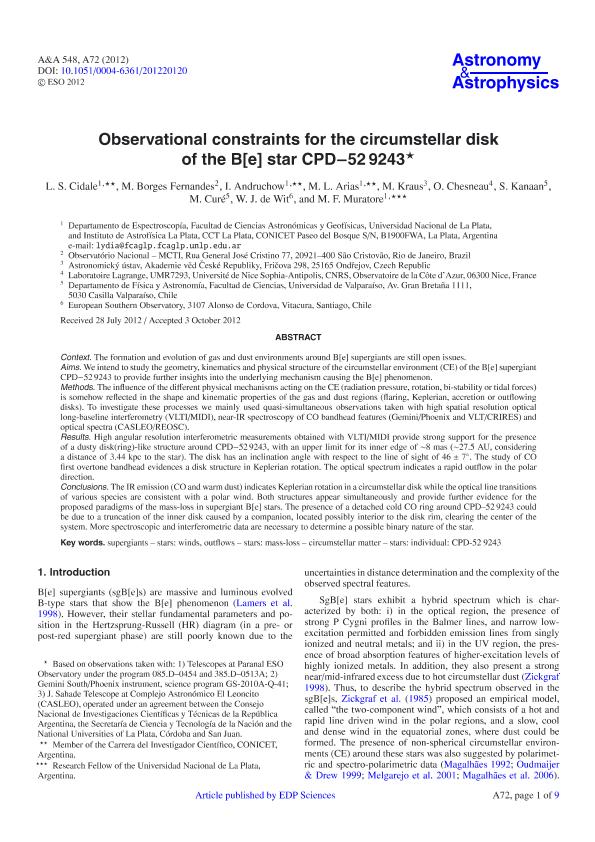Mostrar el registro sencillo del ítem
dc.contributor.author
Cidale, Lydia Sonia

dc.contributor.author
Borges Fernandes, M.
dc.contributor.author
Andruchow, Ileana

dc.contributor.author
Arias, María Laura

dc.contributor.author
Kraus, M.
dc.contributor.author
Chesneau, O.
dc.contributor.author
Kanaan, S.
dc.contributor.author
Cure, M.
dc.contributor.author
de Wit, W. J.
dc.contributor.author
Muratore, M. F.
dc.date.available
2016-11-23T14:54:20Z
dc.date.issued
2012-10
dc.identifier.citation
Cidale, Lydia Sonia; Borges Fernandes, M.; Andruchow, Ileana; Arias, María Laura; Kraus, M.; et al.; Observational constraints for the circumstellar disk of the B[e] star CPD-52 9243; Edp Sciences; Astronomy And Astrophysics; 548; A72; 10-2012; 1-9
dc.identifier.issn
0004-6361
dc.identifier.uri
http://hdl.handle.net/11336/8289
dc.description.abstract
Context. The formation and evolution of gas and dust environments around B[e] supergiants are still open issues.
Aims. We intend to study the geometry, kinematics and physical structure of the circumstellar environment (CE) of the B[e] supergiant CPD−52 9243 to provide further insights into the underlying mechanism causing the B[e] phenomenon.
Methods. The influence of the different physical mechanisms acting on the CE (radiation pressure, rotation, bi-stability or tidal forces) is somehow reflected in the shape and kinematic properties of the gas and dust regions (flaring, Keplerian, accretion or outflowing disks). To investigate these processes we mainly used quasi-simultaneous observations taken with high spatial resolution optical long-baseline interferometry (VLTI/MIDI), near-IR spectroscopy of CO bandhead features (Gemini/Phoenix and VLT/CRIRES) and optical spectra (CASLEO/REOSC).
Results. High angular resolution interferometric measurements obtained with VLTI/MIDI provide strong support for the presence of a dusty disk(ring)-like structure around CPD−52 9243, with an upper limit for its inner edge of ~8 mas (~27.5 AU, considering a distance of 3.44 kpc to the star). The disk has an inclination angle with respect to the line of sight of 46 ± 7°. The study of CO first overtone bandhead evidences a disk structure in Keplerian rotation. The optical spectrum indicates a rapid outflow in the polar direction.
Conclusions. The IR emission (CO and warm dust) indicates Keplerian rotation in a circumstellar disk while the optical line transitions of various species are consistent with a polar wind. Both structures appear simultaneously and provide further evidence for the proposed paradigms of the mass-loss in supergiant B[e] stars. The presence of a detached cold CO ring around CPD–52 9243 could be due to a truncation of the inner disk caused by a companion, located possibly interior to the disk rim, clearing the center of the system. More spectroscopic and interferometric data are necessary to determine a possible binary nature of the star.
dc.format
application/pdf
dc.language.iso
eng
dc.publisher
Edp Sciences

dc.rights
info:eu-repo/semantics/openAccess
dc.rights.uri
https://creativecommons.org/licenses/by/2.5/ar/
dc.subject
Supergiants
dc.subject
Circumstellar Matter
dc.subject
Winds
dc.subject.classification
Astronomía

dc.subject.classification
Ciencias Físicas

dc.subject.classification
CIENCIAS NATURALES Y EXACTAS

dc.title
Observational constraints for the circumstellar disk of the B[e] star CPD-52 9243
dc.type
info:eu-repo/semantics/article
dc.type
info:ar-repo/semantics/artículo
dc.type
info:eu-repo/semantics/publishedVersion
dc.date.updated
2016-11-18T15:11:27Z
dc.journal.volume
548
dc.journal.number
A72
dc.journal.pagination
1-9
dc.journal.pais
Francia

dc.journal.ciudad
Paris
dc.description.fil
Fil: Cidale, Lydia Sonia. Consejo Nacional de Investigaciones Científicas y Técnicas. Centro Científico Tecnológico la Plata. Instituto de Astrofísica de la Plata; Argentina. Universidad Nacional de la Plata. Facultad de Ciencias Astronómicas y Geofísicas; Argentina
dc.description.fil
Fil: Borges Fernandes, M.. Ministério de Ciencia, Tecnologia E Innovacao. Observatorio Nacional; Brasil
dc.description.fil
Fil: Andruchow, Ileana. Consejo Nacional de Investigaciones Científicas y Técnicas. Centro Científico Tecnológico la Plata. Instituto de Astrofísica de la Plata; Argentina. Universidad Nacional de la Plata. Facultad de Ciencias Astronómicas y Geofísicas; Argentina
dc.description.fil
Fil: Arias, María Laura. Consejo Nacional de Investigaciones Científicas y Técnicas. Centro Científico Tecnológico la Plata. Instituto de Astrofísica de la Plata; Argentina. Universidad Nacional de la Plata. Facultad de Ciencias Astronómicas y Geofísicas; Argentina
dc.description.fil
Fil: Kraus, M.. Astronomicky Ustav; República Checa
dc.description.fil
Fil: Chesneau, O.. Laboratoire Lagrange; Francia
dc.description.fil
Fil: Kanaan, S.. Universidad de Valparaiso. Departamento de Física y Astronomía; Chile
dc.description.fil
Fil: Cure, M.. Universidad de Valparaiso. Departamento de Física y Astronomía; Chile
dc.description.fil
Fil: de Wit, W. J.. European Southern Observatory, Chile;
dc.description.fil
Fil: Muratore, M. F.. Consejo Nacional de Investigaciones Científicas y Técnicas. Centro Científico Tecnológico la Plata. Instituto de Astrofísica de la Plata; Argentina. Universidad Nacional de la Plata. Facultad de Ciencias Astronómicas y Geofísicas; Argentina
dc.journal.title
Astronomy And Astrophysics

dc.relation.alternativeid
info:eu-repo/semantics/altIdentifier/url/http://adsabs.harvard.edu/abs/2012A%26A...548A..72C
dc.relation.alternativeid
info:eu-repo/semantics/altIdentifier/url/http://www.aanda.org/articles/aa/abs/2012/12/aa20120-12/aa20120-12.html
dc.relation.alternativeid
info:eu-repo/semantics/altIdentifier/doi/http://dx.doi.org/10.1051/0004-6361/201220120
Archivos asociados
